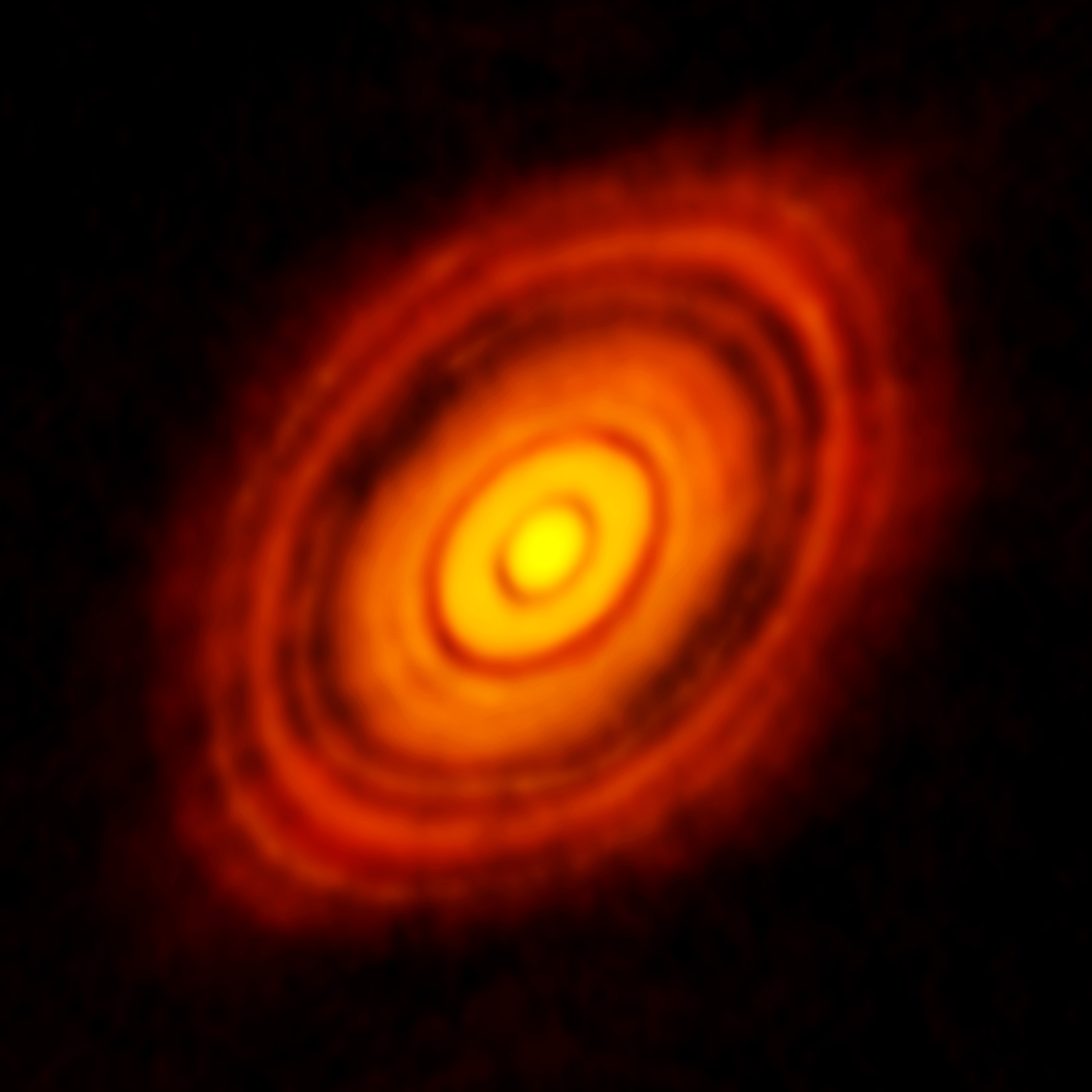NOVEMBER 1, 1577: Observers in Peru make the first sighting of the Great Comet of 1577. This comet, a brilliant object which is often referred to as “Tycho Brahe’s Comet” and which is one of the most important scientific comets in history, is next week’s “Comet of the Week.”
NOVEMBER 1, 1948: Observers on the ground near Nairobi, Kenya, as well as in a Royal Air Force plane flying at 4000 meters, detect a bright comet near the sun during a total solar eclipse. The Eclipse Comet of 1948 and other “eclipse comets” are the subject of a previous “Special Topics” presentation.
NOVEMBER 1, 1975: University of California astronomer Martin Cohen publishes a paper announcing the likely presence of water ice surrounding the young solar-type star HL Tauri. A protoplanetary disk has since been detected surrounding this star. The significance of Cohen’s discovery is discussed in a previous “Special Topics” presentation.

NOVEMBER 1, 1998: A team led by William Merline discovers a moon since named Petit-Prince, around the main-belt asteroid (45) Eugenia with the Canada-France-Hawaii Telescope at Mauna Kea. This was the first asteroid moon to be discovered with a ground-based telescope, and only the second asteroid moon ever to be discovered. A second moon around Eugenia was discovered in 2004. Asteroid moons are the subject of a previous “Special Topics” presentation.
NOVEMBER 1, 2020: The main-belt asteroid (149) Medusa will occult the 7th-magnitude star HD 69072 in Cancer. The predicted path of the occultation crosses northern India, central Tibet, central China, southern North Korea, northern South Korea, and the northern part of the Japanese island of Honshu.
NOVEMBER 2, 1980: MIT student Paul Kamoun detects the nucleus of Comet 2P/Encke with radar signals utilizing the 300-meter radio telescope at Arecibo, Puerto Rico. This was the first successful detection of a cometary nucleus via radar. Comet 2P/Encke returned to perihelion earlier this year and is a previous “Comet of the Week.”
NOVEMBER 2, 2002: NASA’s Stardust mission flies by the main-belt asteroid (5335) Annefrank while en route to Comet 81P/Wild 2. The Stardust mission is discussed in a previous “Special Topics” presentation.
NOVEMBER 2, 2020: The very tiny near-Earth asteroid 2018 VP1, discovered two years ago by the Zwicky Transient Facility program in California, is expected to make a close flyby of Earth. The asteroid has not been seen in two years and is approaching Earth from the general direction of the sun, and thus the exact circumstances of this encounter are uncertain; the nominal “miss distance” is 0.0021 AU (314,000 km, or 0.8 lunar distances).
NOVEMBER 2, 2021: Comet 67P/Churyumov-Gerasimenko will pass through perihelion at a heliocentric distance of 1.211 AU. During its previous return in 2015 Comet 67P was the destination of ESA’s Rosetta mission, and it is a previous “Comet of the Week.”
NOVEMBER 3, 2020: The main-belt asteroid (519) Sylvania will occult the 7th-magnitude star HD 47255 in Auriga. The predicted path of the occultation crosses south to north across east-central Australia, the province of Papua in Indonesia on the western half of the island of New Guinea, far southwestern South Korea, northeastern China, far northeastern Mongolia, central Russia, western Belarus, and southeastern Poland.
NOVEMBER 4, 2010: NASA’s EPOXI mission flies by Comet 103P/Hartley 2. EPOXI, retooled from the earlier Deep Impact mission, is discussed in a previous “Special Topics” presentation.
NOVEMBER 5, 2005: Images taken with the Canada-France-Hawaii Telescope at Mauna Kea Observatory in Hawaii contain pre-discovery images of Comet Boattini C/2010 U3, which was discovered in October 2010 (during the course of the Mt. Lemmon survey in Arizona) and which passed through perihelion (at a heliocentric distance of 8.45 AU) in February 2019. At the time these images were taken the comet’s heliocentric distance was 25.751 AU, the largest heliocentric distance at which an incoming long-period comet has ever been detected.
NOVEMBER 5, 2012: Astronomers Scott Sheppard and Chad Trujillo discover the “asteroid” 2012 VP113 from Cerro Tololo Inter-American Observatory in Chile. This was the second known object, after (90377) Sedna, to exist entirely within the far outer solar system, and these objects are discussed in next week’s “Special Topics” presentation.
NOVEMBER 5, 2020: The Amor-type asteroid (433) Eros will pass through perihelion at a heliocentric distance of 1.133 AU. It is currently in the morning sky, traveling east-southeastward through the constellation Leo, and is around 13th magnitude. Eros was the first-known near-Earth asteroid and is the subject of a previous “Special Topics” presentation.
NOVEMBER 6, 1892: An amateur astronomer in London, Edwin Holmes, discovers a bright comet located near the Andromeda Galaxy. This comet, now known as Comet 17P/Holmes, has undergone the largest cometary outbursts ever recorded, and is this week’s “Comet of the Week.”
NOVEMBER 7, 1882: The Director of the Cape Observatory in South Africa, David Gill, takes a 100-minute exposure of the Great Comet of 1882 (a previous “Comet of the Week”). Not only was this the first “good” photograph of a comet, but it also showed so many stars that it started a paradigm shift among astronomers regarding the usefulness of astrophotography, and among other things stimulated the first major international collaborative astronomical projects.
NOVEMBER 7, 2018: Amateur astronomer Don Machholz in California visually discovers a 10th-magnitude comet, which is independently discovered later that same morning by two Japanese amateur astronomers (Shigehisa Fujikawa and Masayuki Iwamoto), both of whom were utilizing CCDs. Comet Machholz–Fujikawa-Iwamoto C/2018 V1 was the first comet to be discovered visually in eight years and is the last one to be so discovered as of now; it is conceivable that it may be the last comet ever to be discovered visually.
More from Week 45:
Comet of the Week Special Topic Free PDF Download Glossary
Ice and Stone 2020 Home Page


